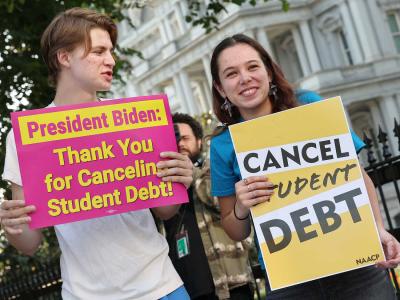Will Student Loans Ever Be Forgiven?
Here's an overview:
- Introduction to Student Loan Forgiveness
- Current State of Student Loan Debt
- Existing Student Loan Forgiveness Programmes
- Debates and Controversies Surrounding Student Loan Forgiveness
- Potential Benefits of Student Loan Forgiveness
- Potential Drawbacks of Student Loan Forgiveness
- Exploring Alternative Solutions to Student Loan Debt
- Public Perception and Political Will for Student Loan Forgiveness
- Impacts of Student Loan Forgiveness on the Economy
- The Future of Student Loan Forgiveness
Introduction to Student Loan Forgiveness
Student loan forgiveness programmes have gained significant attention in recent years as a potential solution to the growing student debt crisis. These programmes aim to provide relief to borrowers by cancelling some or all of their student loan debt under certain circumstances. Here are key points to consider when exploring student loan forgiveness options:
- Public Service Loan Forgiveness (PSLF):
- PSLF is a programme that forgives the remaining balance on Direct Loans after making 120 qualifying monthly payments while working full-time for a qualifying employer, such as government organisations or non-profits.
- Borrowers must meet specific criteria to qualify for PSLF, including being enrolled in an eligible repayment plan.
- Income-Driven Repayment (IDR) Plans:
- IDR plans set monthly student loan payments based on the borrower's income and family size, making them more manageable.
- Remaining balances on loans under IDR plans may be forgiven after a certain number of qualifying payments.
- Teacher Loan Forgiveness:
- Teachers in low-income schools or educational service agencies may be eligible for loan forgiveness after teaching for five consecutive years.
- The maximum forgiveness amount varies based on the subject taught and certification.
- Perkins Loan Cancellation:
- Borrowers with Perkins Loans may qualify for cancellation of a percentage of their loan for each year of service in specific professions like teaching, nursing, or law enforcement.
Navigating the complexities of student loan forgiveness programmes can be daunting, but understanding the available options is crucial for borrowers seeking relief from their debt burden. This section will delve deeper into each forgiveness programme, eligibility requirements, and considerations for borrowers looking to explore these opportunities.
Current State of Student Loan Debt
- As of now, the total outstanding student loan debt in the United States is over $1.7 trillion.
- The average student loan debt for a college graduate in 2021 is approximately $30,000.
- Over 44 million Americans have student loan debt.
- Approximately 11% of student loans are either delinquent or in default.
- Federal student loan debt makes up the majority of the total student loan debt in the country.
- Private student loans represent a smaller but still significant portion of the overall debt.
- There have been multiple initiatives to assist borrowers, such as income-driven repayment plans and Public Service Loan Forgiveness (PSLF) programmes.
- The COVID-19 pandemic led to a temporary suspension of federal student loan payments, providing relief to many borrowers.
- Despite these efforts, student loan debt continues to be a significant financial burden for many individuals and families.
- The issue of student loan forgiveness has become a topic of debate among policymakers and the public.
- The current state of student loan debt underscores the need for comprehensive solutions to address the challenges faced by borrowers.
Existing Student Loan Forgiveness Programmes
- Public Service Loan Forgiveness (PSLF):
- Purpose: Forgives the remaining loan balance for borrowers in qualifying public service jobs after making 120 monthly payments.
- Eligibility: working full-time for a government or nonprofit organisation while making qualifying payments.
- Challenges: high rejection rates due to strict requirements and confusion over eligibility criteria.
- Teacher Loan Forgiveness:
- Purpose: Provides forgiveness of up to $17,500 on direct, Subsidized and unsubsidized loans for eligible teachers.
- Eligibility: Working full-time for five consecutive years in a low-income school or educational service agency.
- Limitations: This only applies to specific types of federal student loans and has strict eligibility criteria.
- Income-Driven Repayment Plans (IDRs):
- Purpose: Adjusts monthly payments based on income and family size, with remaining balances forgiven after 20–25 years of payments.
- Eligibility: Available for all federal student loan borrowers, particularly those with high debt-to-income ratios.
- Considerations: While providing loan forgiveness, borrowers may end up paying more in interest over the extended repayment period.
- Borrower Defence to Repayment:
- Purpose: Allows students defrauded by their schools to seek loan forgiveness.
- Eligibility: Available for borrowers who attended schools engaged in fraud or misrepresentation.
- Challenges: a lengthy application process and uncertain outcomes for borrowers seeking relief.
These existing programmes offer some relief for borrowers struggling to repay their student loans. However, they come with specific criteria and limitations, making it challenging for all borrowers to qualify.
Debates and Controversies Surrounding Student Loan Forgiveness
- Opposing Views:
- Some argue that student loan forgiveness is unfair to those who have already paid off their loans or worked hard to avoid taking out large amounts of student debt. They believe that individuals should be responsible for repaying the loans they agreed to.
- Critics also express concerns about the potential economic impact of widespread student loan forgiveness, questioning how it would be funded and whether it would create moral hazard by encouraging future students to take on excessive debt with the expectation of forgiveness.
- Supporting Arguments:
- Advocates for student loan forgiveness argue that the current student debt crisis disproportionately affects low-income individuals and minority groups, perpetuating cycles of poverty and hindering economic mobility. Forgiveness, they assert, would help alleviate this burden and stimulate the economy as individuals are freed from debt obligations.
- Proponents also point out that student loan forgiveness could address systemic issues within the higher education and loan industry, such as predatory lending practices and rising tuition costs. They argue that these underlying problems need to be addressed through measures like forgiveness to create a more equitable system.
- Political Divide:
- The issue of student loan forgiveness has become polarised along political lines, with progressives generally supporting broad forgiveness measures and conservatives advocating for personal responsibility and limited government intervention. This ideological split has made passing comprehensive forgiveness legislation challenging in divided legislatures.
- Public Perception:
- Public opinion on student loan forgiveness varies, with polls showing mixed views on the topic. While some Americans support forgiveness as a means of addressing student debt and economic disparities, others remain sceptical of the feasibility and fairness of such proposals. Education and awareness campaigns play a crucial role in shaping public perception and influencing policy decisions regarding student loan forgiveness.
Potential Benefits of Student Loan Forgiveness
- Financial Relief: Student loan forgiveness can provide significant financial relief to borrowers who may be struggling to make their monthly payments. This can free up funds for other essential expenses or allow individuals to start saving for the future.
- Economic Stimulus: By forgiving student loans, the government can potentially inject large sums of money back into the economy. This extra cash in the hands of borrowers could lead to increased consumer spending, which can boost economic growth.
- Career Opportunities: With the burden of student loan debt lifted, individuals may feel more empowered to pursue higher-paying career opportunities or start their own businesses. This can lead to increased job satisfaction and overall economic productivity.
- Impact on society: By offering relief to people who might have suffered disproportionately from the rising cost of higher education, student loan forgiveness can help reduce inequality. It can also promote social mobility by removing barriers to financial stability for low-income individuals.
- Psychological Well-being: The stress and anxiety associated with student loan debt can have a significant impact on borrowers' mental health. Forgiveness can alleviate this psychological burden and improve overall well-being.
- Higher Education Accessibility: With student loans forgiven, more individuals may be encouraged to pursue higher education without the fear of crippling debt. This can lead to a more educated and skilled workforce, benefiting society as a whole.
By considering these potential benefits of student loan forgiveness, policymakers can evaluate the impact of such measures on individuals, the economy, and society.
Potential Drawbacks of Student Loan Forgiveness
- Tax Implications: Student loan forgiveness may be considered taxable income by the IRS, potentially resulting in a significant tax bill for the individual.
- Impact on Credit Score: While forgiven loans can help reduce debt, they may also negatively impact the borrower's credit score in the short term, affecting their ability to secure future loans.
- Loss of Incentive to Repay: Some argue that widespread loan forgiveness could create a moral hazard, as it might discourage responsible borrowing behaviour in the future.
- Cost to Taxpayers: Implementing large-scale student loan forgiveness programmes would have significant costs to taxpayers, potentially leading to higher taxes or cuts in other government programmes.
- Fairness Concerns: There are debates about the fairness of loan forgiveness, as some worry that it may benefit higher-income individuals more than those with lower incomes who may not have pursued higher education due to financial constraints.
- Impact on Financial Institutions: Student loan forgiveness could have ripple effects on financial institutions that hold these loans, potentially leading to disruptions in the lending market.
Considering these potential drawbacks, policymakers must carefully weigh the benefits of student loan forgiveness against the possible negative consequences to determine the best path forward.
Exploring Alternative Solutions to Student Loan Debt
- Income-Driven Repayment Plans:
- Income-Driven Repayment (IDR) plans adjust monthly loan payments based on the borrower's income and family size. This can alleviate the burden of high monthly payments for individuals with lower incomes.
- Student Loan Refinancing:
- Refinancing involves acquiring a new loan with more favourable terms to pay off existing student loans. This option can lead to lower interest rates and monthly payments, potentially saving money over time.
- Loan Forgiveness Programmes:
- Certain professions, such as teachers, nurses, and public servants, may qualify for loan forgiveness programmes after a specified period of service. These programmes can help alleviate student loan debt for those in high-demand professions.
- Employer Assistance Programmes:
- Some employers offer assistance with student loan repayment as an employee benefit. This can take the form of direct financial contributions towards loan repayment or access to resources for refinancing options.
- Financial counselling and education:
- Seeking guidance from financial professionals can help individuals better understand their student loan options and create a strategic repayment plan. Education on personal finance management can also prevent future debt accumulation.
- Debt Snowball or Avalanche Method:
- These methods involve prioritising either the smallest or highest interest rate student loans for repayment, respectively. By focusing on one loan at a time, borrowers can gain momentum and accelerate their debt repayment process.
By exploring these alternative solutions to student loan debt, individuals can empower themselves to better manage and eventually alleviate the financial burden of higher education expenses.
Public Perception and Political Will for Student Loan Forgiveness
- Many Americans support student loan forgiveness as a means to alleviate the burden of debt on individuals and families.
- Public perception indicates a growing concern over the economic impact of student loans on borrowers' financial stability.
- Politicians are increasingly pressured to address the student loan crisis as a key issue on their political agenda.
- The call for student loan forgiveness has gained traction in recent years, with prominent figures advocating for significant reforms.
- Student loan forgiveness is viewed as a potential solution to address the widening wealth gap and promote economic equality among citizens.
- The debate surrounding student loan forgiveness showcases a divide between proponents emphasising social responsibility and opponents questioning the feasibility and fairness of such programmes.
- Economic considerations, political ideologies, and public opinion are just a few of the variables that affect policymakers' willingness to implement student loan forgiveness policies.
- The interaction between public perception and political will is crucial in determining the future of student loan forgiveness initiatives.
- As discussions on student loan forgiveness continue to evolve, understanding the dynamics between public sentiment and governmental actions is essential in shaping policies that address the challenges faced by borrowers.
Impacts of Student Loan Forgiveness on the Economy
- Student loan forgiveness can stimulate the economy by freeing up funds that borrowers would have otherwise used to repay their debts, allowing them to spend on goods and services, thus boosting consumer spending.
- With a reduced student loan debt burden, individuals may be more inclined to make large purchases such as homes or cars, which can further stimulate economic growth.
- Forgiving student loans can also lead to increased entrepreneurship as individuals are less constrained by debt, allowing them to take more risks and start their own businesses, ultimately contributing to economic innovation and job creation.
- Lower student loan debt may enable individuals to save more for retirement, invest in the stock market, or pursue higher education, all of which can have positive ripple effects on the economy.
- However, critics argue that student loan forgiveness may result in higher taxes or government debt, which could have negative implications for long-term economic stability.
- Additionally, there are concerns that forgiving student loans could lead to moral hazard, where individuals may be less inclined to make informed choices about their education and finances if they believe that their debts will be forgiven in the future.
Overall, the economic impacts of student loan forgiveness are multifaceted, with potential benefits such as increased consumer spending and entrepreneurship, as well as concerns regarding fiscal responsibility and individual accountability.
The Future of Student Loan Forgiveness
- Political Landscape: Changes in political leadership can significantly impact the landscape of student loan forgiveness. Depending on the administration in power, policies and programmes related to student loan forgiveness may see substantial shifts.
- Legislative Proposals: Various legislative proposals have been introduced to address the issue of student loan forgiveness. These proposals range from partial forgiveness to the complete cancellation of student debt. The future of student loan forgiveness may hinge on the success of such proposed legislation.
- Public Pressure: With the growing burden of student loan debt on individuals and the economy, there is increasing public pressure on policymakers to find solutions, which may lead to more extensive student loan forgiveness programmes in the future.
- Economic Implications: The long-term economic implications of student loan forgiveness are a crucial consideration. While forgiving student debt can stimulate the economy by freeing up funds for other investments, it also raises concerns about moral hazards and the impact on taxpayers.
- Industry Trends: The student loan industry is continually evolving, with new players entering the market and innovative financing options emerging. These industry trends could influence the future of student loan forgiveness programmes.
- Technological Advancements: Advancements in technology, such as blockchain and artificial intelligence, may provide new solutions for managing and potentially forgiving student loan debt more efficiently in the future.
- Global Perspective: Looking at how other countries address student loan debt and implement forgiveness programmes can offer insights into potential strategies for the future of student loan forgiveness in the United States.
- Education Reform: Addressing the root causes of the student loan debt crisis through education reform initiatives may shape the future of student loan forgiveness by preventing excessive student borrowing in the first place.
The future of student loan forgiveness hinges on a complex interplay of political, economic, social, and technological factors. As these factors continue to evolve, so too will the landscape of student loan forgiveness programmes and policies.



